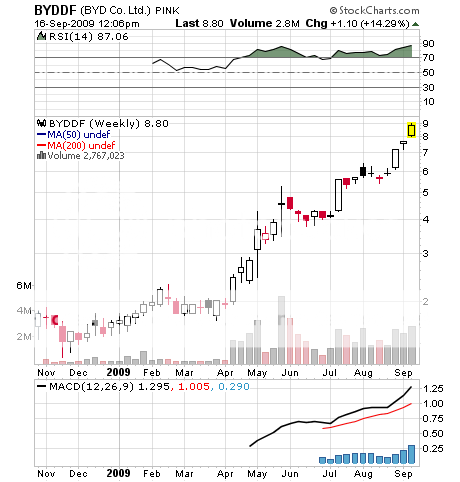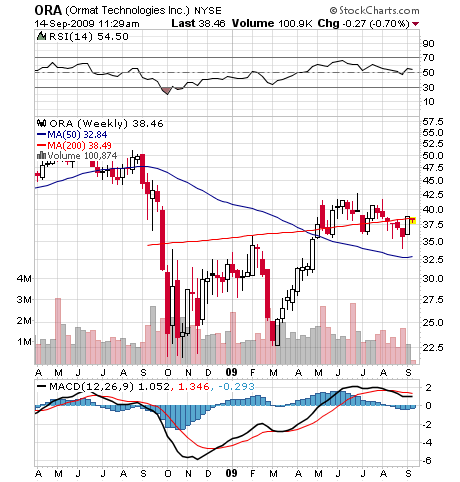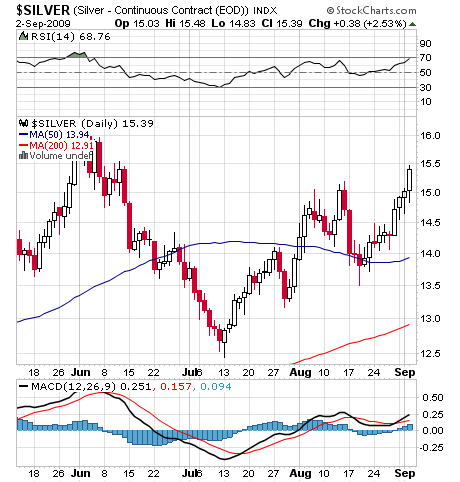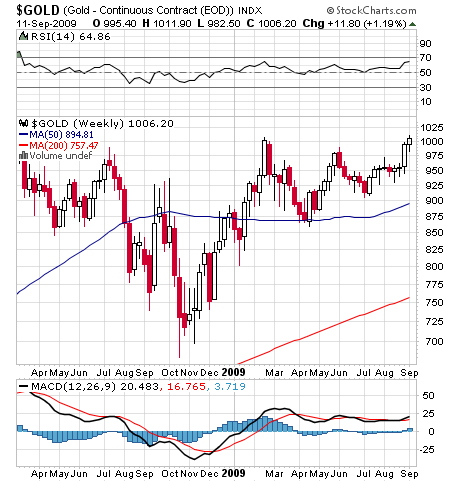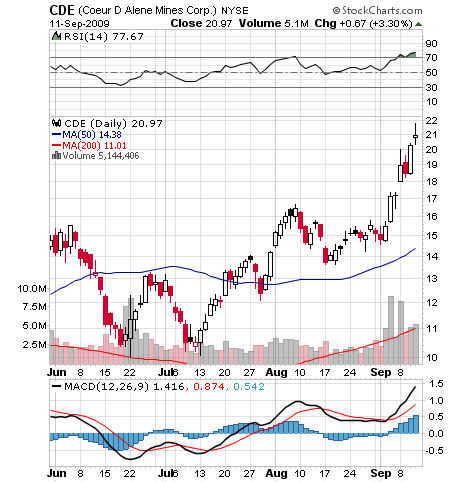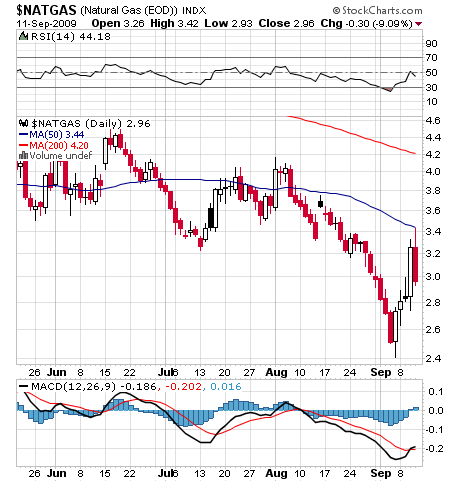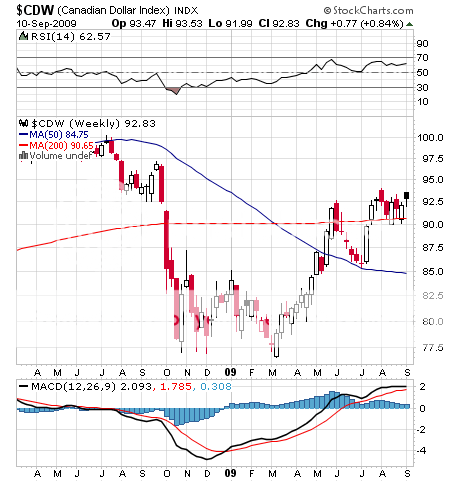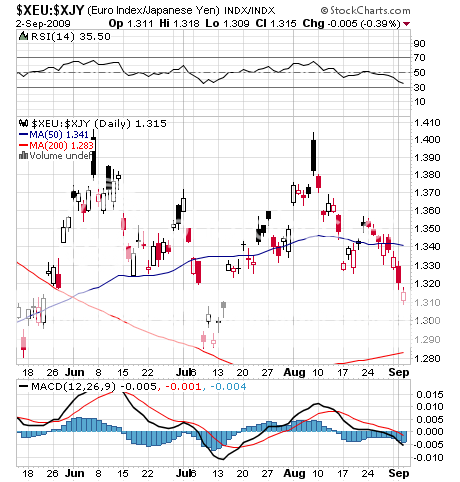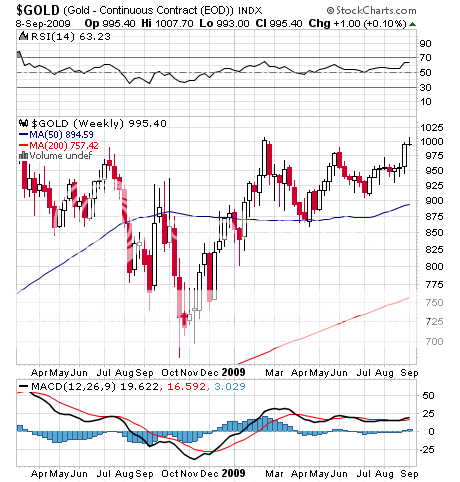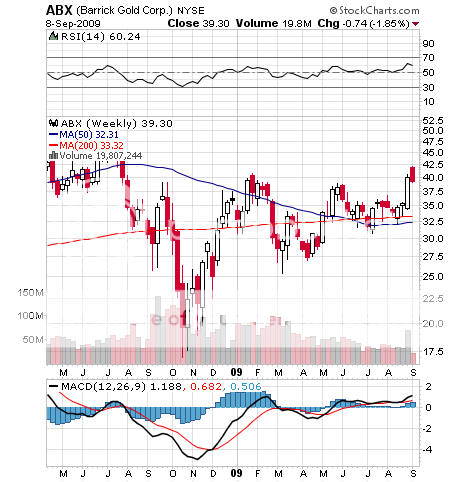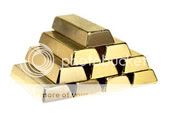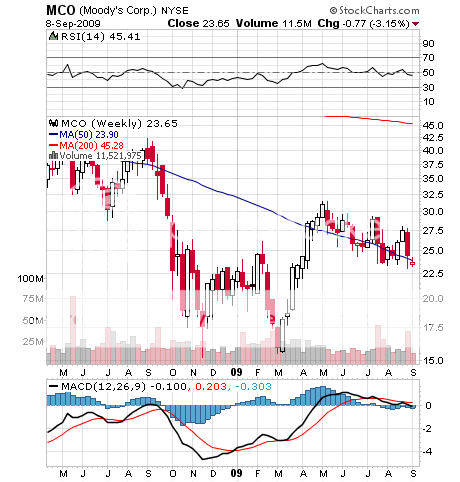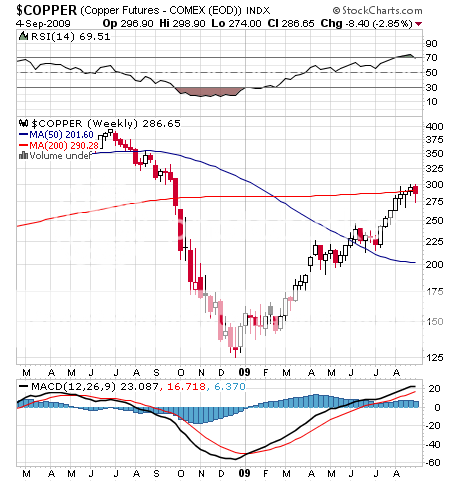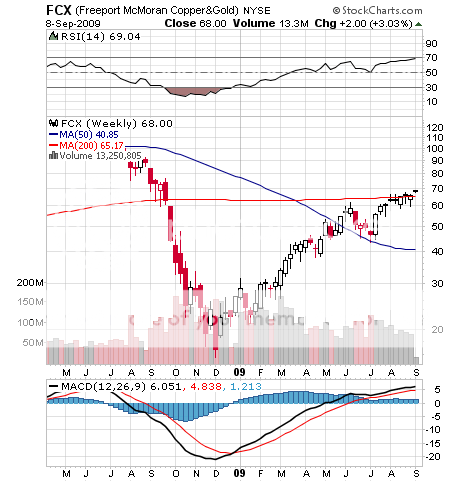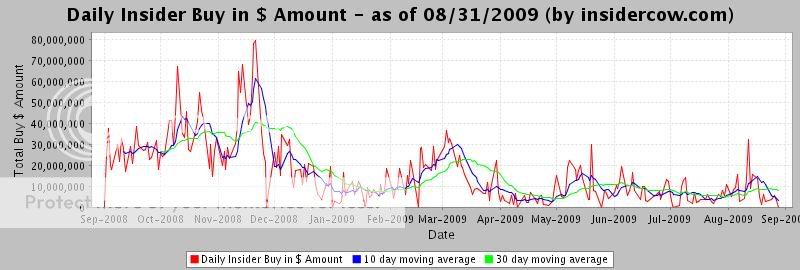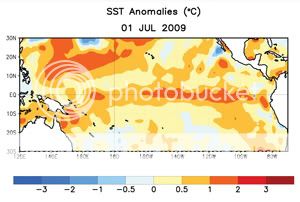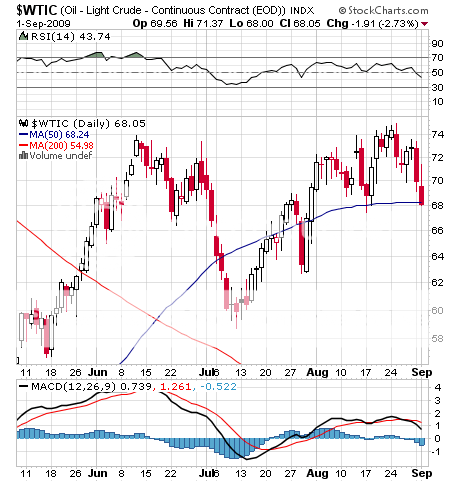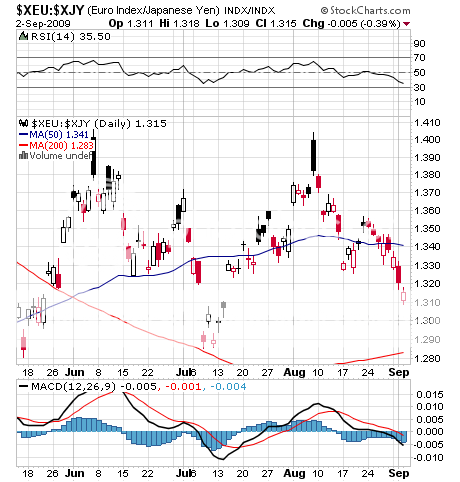
September 17, 2009Featured Trades: (SPX), (BYDDF), (CGW), (PHO), (VE), (FIW), (TTEK), (PNR)
1) Ouch! So much for my ?Sell the Tenth Consecutive Up Day? model. I shorted the S&P 500 September 1050 calls, which expire in two days. The trade was looking good all the way until this morning, when I got stopped out with a 0.5% hickey. It?s no excuse that this works 99% of the time. This is well and truly a liquidity driven market, the kind I used to feast on in Tokyo during 1987-89, when we took Japan?s PE multiple up to 100. The S&P earnings multiple has now made a round trip from 18 times in 2007, to 10 times in March, and back up to 18 times today. Worse, the previous 18 peak was in an era of far rosier economic projections than we are currently grappling with. Don?t fight the tape. Stand out of the way, and let the insanity play itself out before rebalancing your portfolio. At least I have my gold, silver, copper, crude, junk bond, emerging markets, FCX, BYD, water ETF, and short dollar profits to drown my sorrows in.
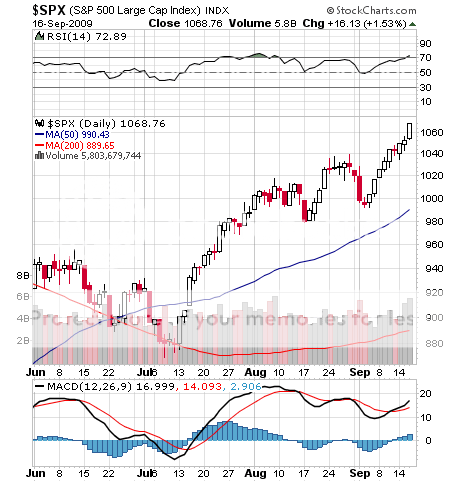
2) When readers ask me about my next ten bagger, I point them to to the Chinese electric car company ?Build Your Dreams? (BYDDF) (click here for their website . The stock is up 450% since I first mentioned it in March, and up 250% since my follow up in June. CEO Wang Chuan-Fu, who Charlie Munger describes as a combination of General Electric?s (GE) legendary manager, Jack Welch, and inventor Thomas Edison, scraped up $300,000 from relatives to start a knock off cell phone battery company in Shenzen in 1995. He grew the company into a massive, vertically integrated conglomerate, employing 130,000 workaholics at 11 factories, including those in Hungary, Romania, and India (interesting choices). BYD bought a defunct car company in 2003, and re-engineered it to launch the $22,000 F3DM sedan last year, an old technology ferrous oxide based plug-in hybrid that gets 62 miles on a charge. General Motors (GMX) Volt and Toyota?s (TM) plug in Prius, which won?t come out until next year, will only get 40 miles per charge and cost more. All-electric models are coming out this year. Warren Buffet was so impressed, he made a rare foreign investment last October, asking for a 25% stake and settling for 10% for $230 million. In a year the Oracle of Omaha has earned a tidy $800 million on the postion. Wang, who has already earned himself a place on the Forbes 400 list, intends to build BYD into the world?s largest automaker, and quickly.
3) If you think that the upcoming energy shortage is going to be bad, it will pale in comparison to the next water crisis, so investment in fresh water infrastructure is going to be a recurring long term investment theme. (See my earlier efforts to get you into the water space by clicking here). One theory about the endless wars in the Middle East since 1918 is that they have really been over water rights. Although Earth is often referred to as the water planet, only 2.5% is fresh, and three quarters of that is locked up in ice at the North and South poles. In places like China, with a quarter of the world?s population, up to 90% of the fresh water is already polluted, some irretrievably so. Some 18% of the world population lacks access to potable water, and demand is expected to rise by 40% in the next 20 years. Aquifers in the US, which took nature millennia to create, are approaching exhaustion. While membrane osmosis technologies exist to convert sea water into fresh, they use ten times more energy than current treatment processes, a real problem if you don?t have any, and will easily double the end cost to consumers. While it may take 16 pounds of grain to produce a pound of beef, it takes a staggering 2,416 gallons of water to do the same. The UN says that $11 billion a year is needed for water infrastructure investment, and $15 billion of the US stimulus package will be similarly spent. It says a lot that when I went to the UC Berkeley School of Engineering to research this piece, most of the experts in the field had already been retained by major hedge funds! At the top of the shopping list to participate here should be the Claymore S&P Global Water Index ETF (CGW), which has appreciated by 50% since I first brought it up. You can also visit the PowerShares Water Resource Portfolio (PHO), the First Trust ISE Water Index Fund (FIW), or the individual stocks Veolia Environment (VE), Tetra-Tech (TTEK), and Pentair (PNR). Who has the world?s greatest per capita water resources? Siberia, which could become a major exporter to China in the decades to come.
?In order to stay on a sugar high, you need to have a continuous injection of sugar,? said Mohamed El-Erian, co-CEO of PIMCO, the world largest bond mutual fund.

September 16, 2009
Featured Trades: (SPX),
(NATIONAL IGNITION FACILITY),
(ECONOMICS BLOGS)
1) Fed chairman Ben Bernanke says the recession is 'technically' over. This will be great news for the homeless living in the tent city under short finals who I fly over when I land my plane at Buchanan airport. It means 'technically' they will eat tonight. It will also be welcome to the 18% of the workforce who are now unemployed in California, the 1.5 million who are losing unemployment benefits in the next three months, and one million college students who ran up and average $30,000 in debt to graduate this year so they could sleep on their parents' sofa. Traders celebrated the news by running the S&P 500 up to 1,054, a positively nose bleeding 58% above the March 9 low. Apparently, the stock market thinks Obama is the greatest president in history, rising some 40% since the inauguration, compared to a 30% drop during the eight years of Bush rule. That is some report card I wonder what the results will be by 2012 and 2016? The only thing I approve of today is that this love fest took silver to a new high this year of over $17. Wake me up when the party is over, and I'll drag your drunken carcasses into the car and drive you home. Then I'm going to cash in a couple of my silver dollars and take my significant other out for a Corona and some vegetarian burritos.
2) Traditional brokerage houses are ditching in-house research as fast as they can in their desperate effort to cut costs. No one ever paid for it anyway. The trend is driving masses of individual investors to the blogosphere for their investment advice, creating a new generation of online superstars. Without clients to offend or an investment banking department to kowtow to, you get an independent view that is often unavailable anywhere else. With most still mired in the collapse of business, blogs about the economy, in particular, have been catapulted into the limelight, some seeing their online traffic soar to 100,000 page views a day. If you want to reliably cover all the bases, then http://blogs.wsj.com/economics offers the collective effort of Rupert Murdoch's conservative Wall Street Journal writers. Another conservative view can be found at http://gregmankiw.blogspot.com , prepared by Bush's chairman of the Council of Economic Advisors, Harvard professor Greg Mankiw. If you want to see Obama lambasted for not being liberal enough, visit Nobel Prize winner and ardent Keynesian Paul Krugman's http://krugman.blogs.nytimes.com . A former IMF economist now at MIT, Simon Johnson launched http://www.baselinescenario.com last year, and it became an instant hit. For great macro analysis, go to www.econbrowser.com, written by the original James Hamilton at the University of California at San Diego (where I attended summer school one year to check out Black's Beach). If you are a neophyte to the economics world, and no one will think less of you if you are, then go to http://economistmom.com . I suggest visiting these sites, finding you comfort level, and tracking them over time, as I would with any new research source.
3) Expect to hear a lot about ignition in the next year. No, I don't mean the rebuilt ignition for the beat up '68 Cadillac El Dorado up on blocks in your front yard. I'm referring to the inauguration of the National Ignition Facility next door to me at Lawrence Livermore National Labs. The home of the hydrogen bomb was set up amid the vineyards and cow pastures of this bucolic California suburb, so if someone accidently flipped the wrong switch, it wouldn't blow up San Francisco, or more importantly, Berkeley. The $5 billion project aims 192 lasers at a piece of frozen hydrogen, using fusion to convert it to helium and unlimited amounts of clean energy. The heat released by this process reaches 100 million degrees, hotter than the core of the sun, and will be used to fuel convention steam electric power plants. There is no need for a four foot thick reinforced concrete containment structure that accounts for half the construction cost of conventional nuclear plants. The entire facility is housed in a large warehouse. The raw material is seawater, and a byproduct is liquid hydrogen, which can be used to fuel cars, trucks, and aircraft. If this all sounds like it is out of Star Trek, you'd be right. I worked with these guys in the early seventies, back when math was used to make things, and before it was used to game financial markets, and I can tell you, there is not a smarter and more dedicated bunch of people on the planet.?? If it works, we will get unlimited amounts of clean energy for low cost in about 20 years. Oil will only be used to make plastics and fertilizer, taking the price down to $10 for domestic production only. The crude left in the Middle East will become worthless.?? Coal will only be found in museums, or in jewelry. If it doesn't work, it will melt the adjacent Mt. Diablo and take me with it. If you don't get your newsletter tomorrow, you'll know what happened.
QUOTE OF THE DAY
'We have gone from discounting everything that could possibly go wrong, to discounting everything that could possibly go right,' said Bernie McGinn, CIO of McGinn, McKean, & O'Neill.
September 15, 2009
Featured Trades: (GEOTHERMAL)
('W' RECOVERY)
1)The dinosaurs of the market, like myself, are collectively being struck by the similarity of the current stock market and that of September 1987, just before the one day, 25% plunge in the Dow. That was when I tied to buy stock with the index down 300 from a payphone in Paris, only to have the trader at Morgan Stanley burst into tears and smash the phone down on the desk (remember that David G.?). My new guru is Gluskin Sheff's strategist David Rosenberg, who says that stocks have already discounted two years of recovery and now carry a lot of risk. It is priced for 40% EPS growth and a 'V' shaped recovery, which we have zero chance of getting. GDP this year will come in at negative 2.5%, and will claw back a listless 1-2% rate in 2010. Stocks are discounting a 4% GDP growth, compared to only 2% for bonds, so he'd much rather own those. With a deflation rate of minus 2% and high yield returns of 12%, junk now offers a 14% inflation adjusted yield, not bad. The secular 25 year bull market in credit expansion is over. Rent still accounts for a third of the CPI, and they are falling for the first time in 17 years. Sure, we'll see ephemeral sugar highs like those for cash-for-clunkers and the tax credit for first time home buyers. But at best, it will only add up to a series of small 'W''s, or what I refer to the as the 'square root' shaped recovery. With the price of everything stretched, you better start reeling in some of that risk.
2) Until now, you had to live on the side of a volcano for geothermal energy to work profitably, as in Iceland, where lucky residents can sink a pipe a few hundred feet in their backyard to get a lifetime of free heat. Elsewhere, they had to be kept alive by massive dollops of subsidies in order to produce very high cost electricity for local utilities. But $350 million in new research funded by Obama's stimulus package is threatening to finally make it economic. The first oil crisis in the seventies spawned firms like Calpine, which exploited massive geyser fields in Northern California marked by hundreds of steam plumes. Unfortunately, low oil prices and technical difficulties, like constantly clogging pipes, starved the industry of new capital, and Calpine went bankrupt.?? Now, a breakthrough technology called Enhanced Geothermal Systems (EGS), where water is pumped down through pipes to 16,000 feet and comes back as superheated steam to run a conventional turbine, is promising to drive costs down dramatically. These plants use minimal amounts of land, conserve water with their closed systems, and unlike solar and wind, operate 24/7. Once built, they produce power at 6.9 cents/kw, vs. 3 cents for coal, 12 cents for wind, and 15 cents for solar. The downside is that these plants are expensive to build, face permitting bottlenecks, need new transmission lines , and may cause earthquakes, so they can't be built near populated areas. The play here is that utilities in many states, like Pacific Gas & Electric (PGE) in California, are legally obligated to obtain high percentages of the power from renewable sources in the near future, whatever the cost. In PGE's case it is 20% by 2017. The Golden State already leads the world in geothermal output, and this will double from 2,605 MW by 2015.?? A larger installed base will bring economies of scale and a further drop in costs. The recent excitement caused Magma Energy's (MGMXF.PK)?? $87 million IPO to be oversubscribed. Better value can be found in Reno, NV based Ormat Technologies (ORA), which boasts operations in the US, Israel, the Philippines, Kenya, Nicaragua, and New Zealand. Check out their website by clicking here at http://www.ormat.com/
3) It's another sign of the times when the weekend fruit picker population is doubled by people hard hit by the economy,?? looking to save money on food costs. After driving through miles of undulating brown hills studded with oak trees, passing mile upon mile of horse ranches, rusted out cars, and abandoned mobile homes, you come to Brentwood, the fruit capital of Northern California. There, thousands of families harvested ripe bing cherries and peaches at the wholesale price of $1 a pound, fruit that normally costs $6 a pound at the supermarket. Anything you eat in the orchard is free. All a great deal if you don't mind having purple fingertips at the end of the day. Just watch out for the cars pulled over on the side of the road on the way home, their occupants puking out all their excess cherries. In a nod to the 21st century, growers in this Grapes of Wrath industry compile lists of email addresses, and notify their itinerant fruit pickers which crops are ready for harvest via the Internet. Also on the calendar this season are grapes, apples, apricots, plums, loquats, nectarines, mandarin oranges, and wheel chair accessible walnuts (?). At the end of each harvest, professional crews sweep through and pick up what's left, if the prices will bear it. If you wonder why we put up with the earthquakes, high taxes, gridlocked politics, and a non functioning state government, this is the reason. By the way, does anyone know what to do with 25 pounds of cherries? Send me your recipes.
QUOTE OF THE DAY
'Wall Street packages luck, and sells it as skill,' said Dan Solin, author of The Smartest Retirement Book You'll Ever Read.
September 14, 2009 Special Silver Issue
Featured Trades: (SILVER), (CDE), (SLW), |
(HL), (UNG), (NATURAL GAS), (MS)
1) Those transfixed by gold blasting through the $1,000 level have been missing the real action in silver. The white metal has soared 57% to $17 since the beginning of the year, compared to only a 22% move for the barbaric relic, an outperformance of almost three to one. I have been a raging bull on silver all year, and on May 7, grabbed you by the lapels and shook you senseless if you didn?t buy at $12.70 (click here for earlier report ). It is nothing less than owning gold with a turbocharger. Silver gives you a nice double play. Its qualities as a precious metal are giving it a major boost from the flight from the dollar, one of this year?s certainties.?? It is also an industrial commodity, which unlike gold, is consumed, and therefore gives you a call on the recovering economy. If you don?t think this move is real, check out the shares of the silver producers. Coeur D Alene Mines (CDE) has rocketed by 57% this month and is up 144% YTD, while Silver Wheaton (SLW), and Hecla Mining (HL) have also done well.?? If you want to get set up on buying silver futures, e-mail me at madhedgefundtrader@yahoo.com and I?ll tell you how to do it. To accumulate .999 fine silver dollars for only a buck over spot, or bullion at the lowest spreads in the market, visit www.mileniummetals.net by clicking here. How long will it take to get to the old high of $50? The Hunt brothers must be grinding their teeth.
2) Since I have had such a hot hand in natural gas (see my call to sell at $4.30 in June by clicking here ), many have asked me to comment on yesterday?s surprise announcement that the ETF, UNG, finally got permission to issue new shares. The easy answer here is that UNG will crater. There is no reason for the fund to trade at a premium, whatsoever, which at one point traded as high as 20%, an overvaluation you normally only see in closed end funds at bear market bottoms. These ETF?s are simply pass through vehicles which make it easier for investors to own NG in stock form when they are legally unable, or too lazy to open a futures trading account. They should never trade more than 1% out of line with the underlying to account for the admin and execution costs of running such an instrument. The people who made the killing? here were the handful of hedge funds that were able to borrow UNG shares, sell them short, and go long the futures, locking in a guaranteed 20% spread. They will cash in their profit next week. Something similar is still going on where smart industry players have locked up salt caverns to store gas, buy it cheaply on the spot market, and sell it forward. This is possible because yesterday you could buy October at $3.25/MCF and sell it for April delivery at $5.32, giving you an annualized return of 127%. Leverage that, and you are talking about some serious money. If you were wondering where the money was coming from to buy those G5?s, this is it. The fundamentals for the industry are still terrible, and there is a risk that the market could completely grind to a halt when the country runs out of storage, so the volatility will remain huge. This week?s explosive 44% move from $2.40 to $3.44 was nothing more than pure short covering. I expect a quick double in NG once the storage issue is resolved, and the cheapest, cleanest, and most liquid way to participate is through the futures. If you need help in how to do this, e-mail me at madhedgefundtrader@yahoo.com.

3) The retirement of John Mack as the CEO at Morgan Stanley truly marks the end of an era at the venerable, once white shoed investment bank. I knew John 30 years ago when he ran fixed income sales, and every bond salesman lived in terror of his very shadow. Don?t let his relaxed, easy going demeanor on TV fool you. He was truly aggression distilled, the head piranha in a river full of piranhas, and is the main reason I became an equity guy. The former Duke football player once had counters installed on his department?s phones to tally outgoing calls, and fired the least loquacious producers, earning the sobriquet ?Mack the Knife.??? Another time, when the firm was trying to muscle its way into a corner of the bond business, he spent months recruiting a top trader from another leading house, only to fire him on the first day. To a class of young incoming MBA?s he showed a slide of a heavily hirsute laughing man walking out of a shower, wearing only soap suds in the key areas, and told them ?This is how we like to leave our clients, plucked clean and happy.? Jaws dropped when we realized it was a picture of him in his frat days. He surfed a massive wave of government and corporate debt issuance to the top of MS. When a prestigious golf club turned him down for membership, no doubt because of his Lebanese heritage, he set up his own. I shall leave the darker urban legends confined to the dustbin of history. Waleed Chama will take over as president of Morgan Stanley International, a more sober banker there never was. We traipsed around the Persian Gulf sheikdoms together in the old days, when the long range artillery from the Iran-Iraq war kept us awake at night at the Kuwait Hilton, and shark eaten bodies of soldiers would wash up on the beach every morning. John will hang on as chairman, which means playing golf full time with the firm?s largest clients. As for the stock, you can expect another double after its near death experience at $6, once the economy gets back to normal.
QUOTE OF THE DAY
?When the music is playing, you have to dance,? said John Mac, retiring CEO of Morgan Stanley, explaining why he ramped the firm?s leverage ratio up to 32 times going into the financial crisis.
September 11, 2009
Featured Trades: (EUROYEN), (HEDGE FUNDS), (CANADIAN DOLLAR)
1) Hedge fund longs have been bunching up in the Canadian dollar for the past two months. Canada makes what everyone wants and doesn?t have enough people to consume it, making them a major exporter of everything hot. I bet you didn?t know that the frozen wasteland to the North is our largest foreign oil supplier. Most people guess Saudi Arabia. The Canadian supply is slated to double over the next 20 years, thanks to the environmental atrocity of oil sands. The land of Mike Myers, Jim Carey, and Pamela Anderson (note gratuitous photo below) is also a big supplier of gold, silver, lead, grain, uranium, wood, and other hard things. As for mosquitoes, they?ve got a lock on the market. Use dip to accumulate the loony. If you catch me singing ?O Canada? in the shower, you?ll understand why.
2) The euroyen cross has served as my faithful lapdog for 20 years, accurately forecasting the global risk appetite, rising when hedge funds were eager to roll the dice, and retreating when they went into hiding (see my earlier work by clicking here ). But lately this pet has forgotten its house training, much to the delight of my dry cleaner, delivering an unpleasant stream of false signals. When Japanese overnight rates were at zero, and the rest of the world was at 5%, it was easy to let Japan be your piggy bank and finance everything for free by denominating your debt in yen. This carry trade of choice became a strategy on its own. Leverage it ten to one and you earned a handy 50% annual return, and more, if the yen then depreciated. The problem is that the rest of the world has become Japan, with overnight rates everywhere at, or converging on zero, sending the predictive value of euroyen down the toilet. Thus, it joins the dustbin of history with other indicators that drew our collective gazes, like the money supply, the trade deficit, and rail car loadings. If I find a new one, I?ll let you know. Does anyone out there have any suggestions?
3) There is no doubt that hedge funds have been the chief whipping boy for the financial crisis. Fear of rumor mongers and unnamed conspiracies abounded, leading to measures like short selling restrictions, stock lending bans, and punitive new taxes that only caused more damage. The industry even suffered a close call by almost being villainized in Oliver Stone?s upcoming sequel to his landmark film Wall Street. Industry veteran Jim Chanos talked him out of it. The industry is now at last organizing, creating its own Washington lobby group, the Coalition of Private Investment Companies (CPIC), with Chanos as the chairman. They have put up a polished website that provides some basic stats about the business, and seeks to shoot down some of the more egregious urban legends. To access their site at http://www.hedgefundfacts.org.
QUOTE OF THE DAY
?A statistical model build around a normal distribution when applied to markets can be a very dangerous thing,? said David Kelly of JP Morgan.
September 10, 2009 Featured Trades: (GOLD), (ABX), (GLD), (MCO)
1) The precious metals markets were stunned with Barrick Gold?s (ABX) announcement that it will float a $3 billion public offering to retire its gold hedges in the futures markets. This means that the world?s largest producer is cashing in its downside protection and gearing itself for a ballistic move up in the price of the barbaric relic. The timing of the announcement, the day that the yellow metal broke $1,000 for the first time since February, couldn?t have been more auspicious. I have been a huge fan of Peter Munk?s ABX all year, cajoling readers into the stock at $27 in January before its 56% run (click here for report ) . South Africa?s largest gold miner, AngloGold Ashanti?s CEO Mark Cutifani says his company put its money where its mouth is, taking off its hedges some time ago. ?People are doing what they have been doing for 5,000 years, and that is buying gold as the only hard currency,? opines Cutifani. In the meantime, the Street Tracks gold ETF (GLD) announced that it has $34 billion of gold holdings, making it the largest ETF of all, and the fifth largest owner of gold in the world after four central banks. If you want to buy gold bullion or coins for the tightest spread over spot, check out http://www.millenniummetals.net.
2) The case against the Big Three rating agencies took another step forward when a New York judge threw out the freedom of speech defense for one of the complaints. Terry McGraw, CEO of McGraw Hill, and owner of defendant Standard & Poor?s, says that at the peak in 2006, the industry was prepared for a worst case scenario of a 15% draw down in real estate prices over 18 months on the local level. Instead, it got a 50% national plunge that is now two years old and aging. It didn?t help that a Moody?s analyst wrote an e-mail saying he would rate paper issues by ?cows.? In the race for market share, Moody?s, S & P, and Fitches? competitively devalued the meaning of ?AAA? so that even the most toxic subprime sludge came out highly rated. With their seals of approvals, the agencies became the facilitators-in-chief of the over lending and over borrowing that made the crash a mathematical certainty. The hedge funds that made billions wisely ran their own in-house ratings departments which thought otherwise. They fell down on their knees, thanking God that inflated ?independent? ratings led to wild over valuation of debt securities and set up some of the greatest shorts of the century. There is no Hell hot enough to make ratings agencies adequately pay for their deliberate misdirection of trusting investors. As for the hedge funds, their new short play is the one rating agency that is still publicly traded, Moody?s (MCO).
3) Consumer credit plunged by $21 billion in July, taking it down to the lowest level since WWII. The last time it was this low wartime rationing was in effect and a lot of individual purchases ended up in a booming black market. Instead of buying that new Cadillac Escalade with the chrome wheels, they are paring down debt. Gun shy credit card companies are happy to take the money, and American express has been cutting back limits in zip codes with the weakest housing like California and Florida, even for current accounts. Banks have gone back to lending only to people who don?t need the money. The savings rate has gone from zero to 7%, on its way to 10%,?? not exactly a great springboard for an economic boom. The catatonic consumer is the main reason why I have not played equities from the long side since May, preferring instead to dabble in commodities. With 70% of GDP in shrink mode, any move up in the indexes is just fluff. For more reasons on why you should break into an ugly rash before buying stocks at these levels, look at Martin Hutchinson?s piece by clicking here
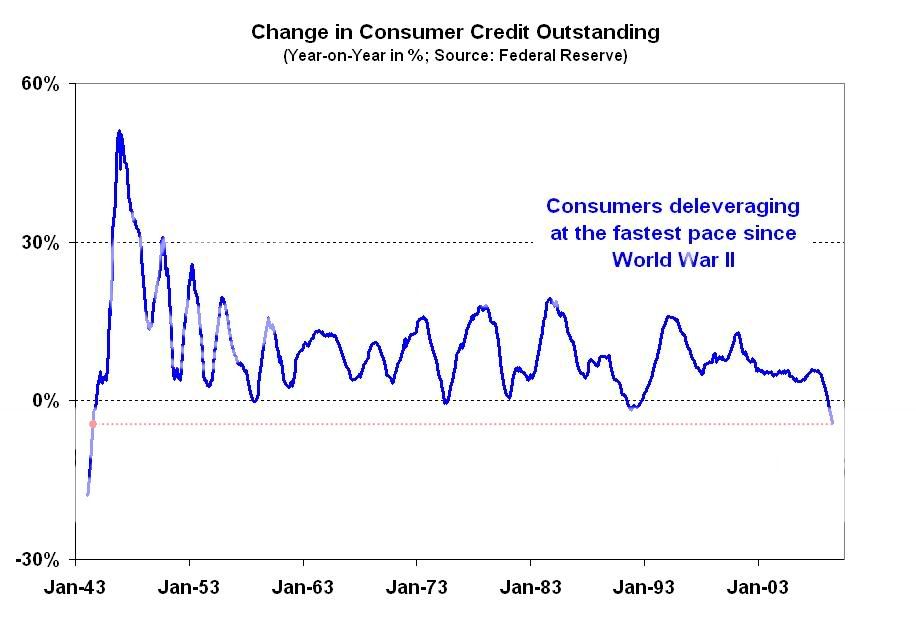
QUOTE OF THE DAY
?Beware of Wall Street geeks bearing formulas,? said Vince Farrell, CIO of Soliel Securities.
September 9, 2009 Featured Trades: (COPPER), (TBT), (FCX), (EUROPE), (DOLLAR)
1) Well, you certainly don?t need my help anymore. With everything in the world going up but the greenback, you certainly don?t need the advice of financial advisors, brokers, pundits, or sadly, even this humble online columnist. I never thought I?d see the day when stocks, bonds, gold, silver, oil, natural gas, copper and collectable beany babies were all up in unison. Not only is the punchbowl ubiquitous, but the Kool-Aide is spiked with ecstasy, and it is so large, that there is a risk we might fall in and drown. Industry analysts are now putting out forecasts for their individual companies implying a 5% GDP growth rate next year, but macroeconomists at those very same houses see 2% as a stretch. All of this in the face of a catatonic consumer, $3.40/ gallon gasoline, and banks maintaining a death grip on lending to any but the primest of borrowers. I guess this is what happens when the Fed is determined to keep interest rates at zero, for as far as the eye can see, and the printing presses in Washington DC are running so fast that I can hear them here in San Francisco. With $4 trillion in cash sitting on the sidelines there is a risk that the faith based rally will continue. Is the Fed trying to cure a burst bubble with a profusion of? bubbles?
2) It?s time to take another look at the short US Treasury bond ETF (TBT). I first recommended this 200% leveraged bet that long dated bonds were going down big time in January at $35, catching a near double to $60 (click here for report) . We have now retrenched back to $45, and it?s time to reload the boat. The US government has now committed to $9.1 trillion in debt issuance over the next ten years. Foreign governments will need to borrow as much to fund their own bail out/stimulus programs. Did I mention inflation? There is absolutely no way the ten year can maintain a 3.40% yield in the face of this onslaught.?? It is clear that zero short rates are driving investors, many of whom will only buy Treasuries, into making terrible investments. This is what the awesome bid to cover ratio of 3.2X for today?s three year auction is telling you. The dollar clearly sees this and is hitting a new one year low. It?s just a matter of time before bond investors put on their bifocals and see the locomotive that is about to run over them.
3) Lack of a pure copper ETF is stampeding hedge funds into the shares of Freeport McMoRan (FCX), the world?s largest copper and gold producer, no doubt spurred by the red metal?s recent run at a new 2009 high.?? FCX is one of my favorite stocks, and one of the great ?tells? on the state of the global economy.?? CEO, Richard Adkerson, says it?s all about ?China, China, China?, which has been frenetically stimulating its economy with a $586 billion reflationary package, and rebuilding stockpiles of the copper at a furious pace. The ongoing lifestyle upgrade in other emerging markets is adding to demand, as is the switch to hybrid cars in industrialized countries, which use two to three times more copper than conventional cars. Last year, FCX mined 102 billion pounds of copper, 40 million ounces of gold, and 266 million ounces of silver. Talk about being in the sweet spot. A doubling of copper prices since January enabled FCX to announce blowout earnings. The stock has more than quadrupled since my New Year recommendation . Did you know that this is the number two performing stock in the S&P 500 this year? If you want a core holding that is in many right places at the right time, use dips to back up the truck for FCX. If you need any help on how to building a position in physical copper, please e-mail me at madhedgefundtrader@yahoo.com
4) The US is turning into Europe. Think high taxes, chronic high unemployment, more government involvement in everything, less innovation, and much lower growth, in exchange for a social safety net and better coffee. That is the message the markets told us by retreating to the 6,000 handle in March, levels not seen since 1996, and down 54% from the 2007 peak. Equity prices will shrink to multiples, in line with permanently lower long term growth rates of maybe 1%-2%, a shadow of the 5% rate seen for much of this decade. Hint: that?s a lot lower than here. Perhaps this is what mature economies are supposed to look like. If someone is holding a gun to your head and you must buy American stocks, only select names that get the bulk of their earnings from overseas. Microsoft (MSFT), Intel (INTC), Oracle, (ORCL), Cisco (CSCO) all get 60%-70% of their profits from overseas, where up to 90% of the real economic growth will come from for the next decade. Commodity, agricultural companies,?? and their ETF?s also fit this picture. As for me, I think I?ll move to Tahiti and live off of coconuts and freshly speared fish, wearing only a loin cloth. Anything is better than becoming French.
?When the fools are dancing, the greater fools are watching,? according to an old Japanese proverb.

September 8, 2009Featured Trades: (NATURAL GAS), (UNG),
(EL NINO), (AGU), (MON), (MOO), (WHEAT), (WZ09)
1)Everyday, I make an effort to speak to a maker, miner, driller, or provider of a service in the real economy. If you keep your head in the financial markets too long, it is easy to lose touch with reality. Yesterday, I spoke to a friend whose company produces large format copies of blue prints, making him a great leading indicator of building trends. His fall in sales has leveled off 40% down from the peak, and layoffs at client developers and architects seem to have dried up. There are some signs of life in shovel ready city and state projects directly benefiting from the stimulus package. A few small private remodels and additions are coming through, but there are absolutely no big projects on the horizon. He is hoping that his business will maintain this low level at least until the first few quarters of 2010. The scary thing is that I get exactly the same answer from everyone I talk to in every industry, be they the butcher, the baker, or the candlestick maker. This is not the stuff that economic recoveries or bull markets are made of. Perhaps this explains why the recent stock market rally has been absolutely devoid of insider buying, unlike previous upturns, as the two year daily chart below attests. When corporate managers and owners don?t want to eat their own cooking, neither do you.
2) Just when I get comfortable with my view on Natural Gas, I get a scratchy, reverberating cell phone call from one of the major formations telling me that I?m being way too bullish. Gas won?t bottom at $2. The free fall will continue until it hits $1. National storage will be completely full imminently top out, and when it does, the producers will have to shut down completely. Since these guys are leveraged up the wazoo, this will trigger a string of bankruptcies, and the majors will fall like dominoes. A hedge fund bust won?t define this bottom, as these guys are all playing from the short side. UNG can?t step in as a buyer of last resort, as the SEC won?t let it issue more stock, and the current shares are trading at a ridiculous 20% premium. One thing we do agree on is that the bottom will look ugly, whatever the spark is. You often get Armageddon type views near market bottoms, but this guy has been dead on right until now. Well, it takes two to make a market. Conclusion: keep NG nailed to your screen, as the widow maker is where the volatility lives.
3)? I stopped by to visit some old friends at the National Oceanic and Atmospheric Administration (NOAA) in Tiburon, California, located at the abandoned Navy base that was home to the Golden Gate Bridge?s antisubmarine net during WWII.? They warned me that we could be headed for an El Ni??o winter (check their site ).So named because all of the fish disappeared off the coast of Chile one Christmas, El Ni??o?s are caused by a sudden warming of ocean temperatures in the Central and Eastern Pacific, which lead to unusual weather patterns. During the last El Ni??o in 1998, the rainfall in San Francisco soared from 20 inches to 100 inches, the American River dykes broke, railroads were destroyed beyond repair, the Sierras got 40 feet of snow, and species of fish like mahi mahi normally found in Hawaii suddenly hit the hooks of happy fishermen in San Francisco Bay. Australia endured a terrible drought. This could all be great for wheat prices and bad for insurance companies, and no doubt many will claim it is all caused by global warming.
4) Fortune magazine ran an excellent article about the flood of institutional money pouring into agricultural land, a sector I have been harping on for some time (see earlier piece ).The amount of arable land per person has fallen precipitously since1960, from 1.1 acres to 0.6 acres, and that could halve again by 2050.Water is about to become even more scarce than land. Productivity gains from new seed types are hitting a wall. Rising incomes in emerging markets is producing more meat eaters, another huge call on grain and water supplies. To produce one pound of beef, you need 16 pounds of grain and over 2,000 gallons of water. China, especially, is in a pickle because it has 20% of the world?s population, but only 7% of the arable land, and it has committed $5 billion to agricultural land in Africa. Similarly, South Korea has leased half the arable land in Madagascar to insure their food supplies. George Soros has snatched up 650,000 acres of land in Argentina and Brazil on the cheap, an area half the size of Rhode Island, and has become the largest shareholder in Potash (POT). Even hedge funds are getting into the game, quietly building portfolios of farms in the Midwest and the South.?? Time to take another look at Agrium (AGU), Monsanto (MON), Wheat (WZ09) and the ag ETF (MOO). Email me at madhedgefundtrader@yahoo.com if you need to know how to execute on any of these.
JOKE OF THE DAY
On Martha?s Vineyard, where President Obama is vacationing, they?ve introduced a new drink, the ?Obamarita.? After knocking down three Obamaritas, the $12 trillion deficit doesn?t look so bad.
September 4, 2009
SPECIAL NON-FARM PAYROLL ISSUE
Featured Trades: (CRUDE), ($WTIC),(DXO)
(GOLD), (GLD), (KGC), (JAG), (RGLD)
1) So who was the dummy that waited until August to lay off their workers? Fire the bastard! Apparently, there are a large number of managers out there who don't read newspapers, watch TV, or talk to anyone, and waited until the Great Depression was nearly two years old to cut costs. That is one of many conclusions I am forced to draw on the news that the August non-farm payroll showed a further hemorrhage of 216,000 jobs, better than the 230,000 consensus, and a big improvement over the 273,000 July figure. But it included downward revisions of 50,000 in June and July, not good. The unemployment rate came in at 9.7%, continuing its relentless march towards double digits. The net net is that the economy has jumped off the top of the Empire State Building, but is now plummeting towards 5th Avenue and the meat wagon at a slower rate. The usual culprits were there; 65,000 jobs lost in construction, 63,000 in manufacturing, and 27,000 in finance. What was truly amazing to me was to see losses in education at the start of the school season. And what is going to happen to the 1.5 million who will exhaust their unemployment benefits by year end? The figures are all proof that there will be no economic recovery without bank lending. Running a business without credit is like trying to complete a marathon while holding your breath. Bring on the 'L.' My many US Navy readers should seriously consider re-upping, as the economy will not see net hiring for a very long time. Just hope we don't invade anyone new.
2) Crude has been trading like a 3X short dollar ETF. If you look at pure supply/demand considerations, oil should be trading in the $40-$50 range, not the $65-$75 range that we have seen. That means that a $25 speculative premium can be laid purely at the door of the big hedge funds. The big oil producing countries, seeing Obama's policies leading to a weak dollar for as far as the eye can see, are also ditching their bucks as fast as they get their hands on them. That is why the Gulf sheikdoms were one of the biggest buyers of crude near last year's $148 peak. This leaves industry insiders clueless about the price direction of their products, not an easy way to run a business. They understand rig counts, tanker deliveries, and depletion rates, not commitment of traders reports, Bollinger bands, and Fibonaccis. No doubt it was their carping that brought regulators to pressure Deutsche Bank to shut down its double long oil ETN (DXO). Of course, this all means the consumer is getting shafted, paying $3.39/gallon at the pump, instead of $2. This premium is causing a drag on the economic recovery as well. Europeans and Japanese who are paying up to $10/gallon are wondering what we are bitching about. Bring on a 'W' recession and poof!, that premium disappears, as it did last year.
3) Just as it is prudent to top up your flood insurance ahead of the hurricane season, investors are loading up on gold ahead of the treacherous September-October stock trading period. Yesterday's $22 move up shows that attempt number six to run the yellow metal up to a new high has begun. Silver happily tagged along for the ride, tacking on 70 cents to $15.49. Historically, September is the best month of the year to own the barbaric relic, showing an average 3.5% gain over the last 20 years. The onset of the Indian wedding season, Ramadan, and the run up to the Christmas and the Chinese New Year jewelry buying binge are all conspiring to give gold a boost.?? A tip off this was coming was the big put selling seen for the shares of the gold ETF (GLD), and Kinross (KGC). One good way to play gold at this late stage might be the shares of highly leveraged unhedged producers like Rangold resources (GOLD), Jaguar Mining (JAG), and royal Gold (RGLD). Confirmation that the markets are moving towards risk aversion can be found in the euroyen chart, which hit a one month low at 131, after double topping at 140.50. If gold does break, it could tack on 20% very quickly to $1,200. Load up on those American gold eagles. If you want to know where to find them in size, check with the experts at http://www.millenniummetals.net by clicking here.
QUOTE OF THE DAY
'Making money on a trade is like getting applause, but you are the only one who hears it,' said Jon Najarian, an ex Chicago bears linebacker who now runs optionmonster.com.
September 3, 2009 Featured Trades: (FNM), (FRE), (UNP)
1) The hedge fund industry is emerging from the ashes of 2008, and will inevitably grab a larger share of the investing public?s assets. Low interest rates and hero status made it way too easy for inexperienced, untested, and sometimes unscrupulous managers to raise new funds that charged management fees as high as 3% with a 50% performance bonus. Behind every ?liar loan? was a bond manager happy to soak it up through securitized Fannie Mae (FNM), Freddie Mac (FRE), or bank debt, shorting Treasuries against them, and then leveraging the 40 basis point spread by 50 times to generate a highly marketable 20% gross return. Never minds the risks. It was easy money, as long as there were lots of liars, which mortgage brokers herded in by droves, and as long as spreads narrowed, which they did for most of the 21st century. By the beginning of 2008, assets under management soared to $2 trillion. The melt down that followed wiped out large numbers of funds, and raised gates for the survivors, making investors wonder if they would ever get their money back. Total assets plunged to $1 trillion in the blink of an eye through a combination of redemptions and market losses. The new era that is emerging will be populated with humbled and chastened managers offering more disclosure, lower fees, no gates, and thanks to Madoff, oodles of third party oversight. Their portfolios will have less leverage, be invested in more liquid securities, and bring in lower returns. But the new generation will also offer investors battle tested strategies that survived the 100 year flood. Bridgewater, with $37 billion in assets, is now the largest hedge fund, followed by JP Morgan with $36 billion, Paulson & Co. at $27 billion, DE Shaw showing $26 billion, and Soros still at a hefty $24 billion. Long track records and a Gucci cachet will assure that these will prosper. Fees settling down to the 1%/20% range. For the rest of us this means more capital bunching up in the most successful trades, as we have already seen this year in financials, China, oil, and copper. It is also going to be much harder to get new funds off the ground.
2) While the month of October has the reputation as the neighborhood slut, it is in fact September that does the real damage to your pocketbook. Yes, that September, the one that started yesterday. Since 1929, the average September has dropped by 1.3%, compared to an average rise of all months of 0.5%. Remember, Lehman went bust in that month last year, and with lead market Shanghai suffering a diabolical August, you have to wonder if history will repeat itself once again. For a more comprehensive analysis of calendar stock market trends, please read William Patalon III?s piece by clicking here
3) I took some time off yesterday to watch a piece of economic history roll through town. The Union Pacific Railway?s (UNP) engine no. 844 roared past, hauling a trainload of retired union members and railroad buffs in its trademark yellow observation cars. The 4-8-4 steam engine was built in 1944 to haul the massive freight trains demanded by a wartime economy. The company has since spent a fortune maintaining the crown jewel of the great age of steam in perfect operating condition. Normally based in Cheyenne, Wyoming, it hurtled over the Rockies and the Sierras to visit us on a heritage tour. Progress of the belching 500 ton behemoth was updated every ten minutes through Twitter?s tweets, which garnered 481 followers by the time it made it to the San Francisco Bay Area. It barreled through the station like a freight train, blasting its whistle, and singing with heat the faces of the enthralled kids. For video of this piece of romantic transportation history, play the video above, or visit my website by clicking here . Sure, I know the train was videoed every 100 feet all the way from Wyoming to here, including by the four guys standing next to me who posted their work on YouTube. Some even chased the train over the Sierras to get multiple shots and put up montages. This is a community of over the top fanatics. But what the hell, it was fun anyway. By the way, UNP shares nearly doubled off the lows this year as it discounted a full blown recovery of the US economy.
?It?s only the stock market that believes laying off 500,000 people in a reporting period is good news,? said Wilber Ross, CEO of Wilber Ross and Co., a distressed asset investor.
?


